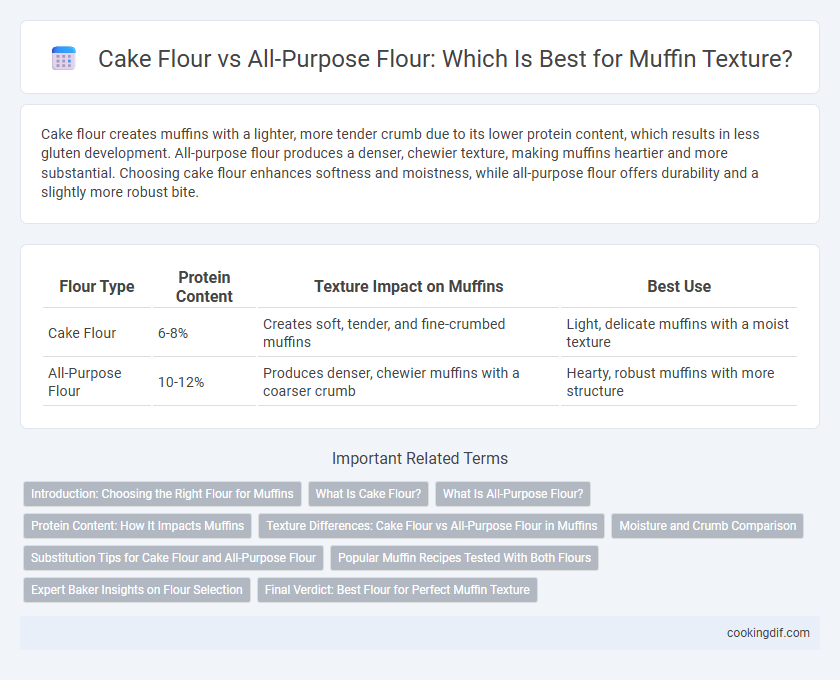Cake flour creates muffins with a lighter, more tender crumb due to its lower protein content, which results in less gluten development. All-purpose flour produces a denser, chewier texture, making muffins heartier and more substantial. Choosing cake flour enhances softness and moistness, while all-purpose flour offers durability and a slightly more robust bite.
Table of Comparison
| Flour Type | Protein Content | Texture Impact on Muffins | Best Use |
|---|---|---|---|
| Cake Flour | 6-8% | Creates soft, tender, and fine-crumbed muffins | Light, delicate muffins with a moist texture |
| All-Purpose Flour | 10-12% | Produces denser, chewier muffins with a coarser crumb | Hearty, robust muffins with more structure |
Introduction: Choosing the Right Flour for Muffins
Cake flour produces muffins with a tender, fine crumb due to its lower protein content, which results in less gluten formation. All-purpose flour offers a denser, chewier texture because of its higher protein levels, providing more structure and rise to muffins. Selecting cake flour enhances softness and lightness, while all-purpose flour contributes to a heartier, more substantial muffin.
What Is Cake Flour?
Cake flour is a finely milled, low-protein flour containing about 7-8% protein, which results in a softer, more tender texture in baked goods. Its lower gluten content compared to all-purpose flour, which has about 10-12% protein, creates lighter and fluffier muffins with a delicate crumb. Using cake flour in muffin recipes enhances moisture retention and prevents toughness, making it ideal for achieving a moist and airy texture.
What Is All-Purpose Flour?
All-purpose flour is a versatile blend of hard and soft wheat, offering moderate protein content around 10-12%, which provides structure and tenderness in baked goods. It produces muffins with a balance of density and softness, making them hearty but not overly crumbly. Compared to cake flour, which has lower protein content and results in lighter, more delicate muffins, all-purpose flour yields a slightly firmer texture ideal for substantial muffins with a moist crumb.
Protein Content: How It Impacts Muffins
Cake flour contains about 7-8% protein, producing a tender, soft crumb in muffins, whereas all-purpose flour has a higher protein content, around 10-12%, resulting in a denser, chewier texture. The lower protein level in cake flour limits gluten development, which enhances the lightness and delicate crumb of muffins. Choosing the right flour based on protein content directly impacts the muffin's moisture retention and overall mouthfeel.
Texture Differences: Cake Flour vs All-Purpose Flour in Muffins
Cake flour produces muffins with a tender, delicate crumb and finer texture due to its lower protein content, which results in less gluten formation. All-purpose flour yields a denser, chewier muffin texture because of its higher protein content that creates more structure and elasticity. Choosing cake flour enhances softness and lightness, while all-purpose flour contributes to a heartier, sturdier muffin body.
Moisture and Crumb Comparison
Cake flour's lower protein content than all-purpose flour creates a softer, more tender crumb in muffins with higher moisture retention, resulting in a delicate, melt-in-the-mouth texture. All-purpose flour produces a denser, chewier crumb with slightly less moisture, giving muffins a heartier structure. The finer grind of cake flour enhances the crumb's delicate texture, while all-purpose flour's balanced protein supports a sturdier, more resilient muffin body.
Substitution Tips for Cake Flour and All-Purpose Flour
Using cake flour instead of all-purpose flour in muffins results in a lighter, more tender crumb due to its lower protein content, while all-purpose flour yields a denser, chewier texture. When substituting cake flour for all-purpose, increase the quantity by about 2 tablespoons per cup and reduce liquid slightly to prevent excess moisture. Conversely, replace cake flour with all-purpose flour by decreasing the amount by 2 tablespoons per cup and possibly adding a teaspoon of cornstarch to mimic cake flour's softness.
Popular Muffin Recipes Tested With Both Flours
Popular muffin recipes tested with both cake flour and all-purpose flour reveal distinct texture outcomes: cake flour produces a lighter, softer crumb due to its lower protein content, while all-purpose flour yields a denser, sturdier muffin. Recipes such as blueberry, chocolate chip, and banana nut muffins showcase how cake flour enhances tenderness and crumb fineness, making each bite more delicate. Bakers seeking a moist, fluffy muffin often prefer cake flour, whereas those prioritizing structure and chewiness lean toward all-purpose flour for optimal results.
Expert Baker Insights on Flour Selection
Expert bakers highlight that cake flour, with its lower protein content (7-9%), creates a tender, delicate crumb ideal for moist, soft muffins, while all-purpose flour's higher protein (10-12%) yields a denser, chewier texture. Precise flour selection influences gluten development, directly affecting muffin rise and mouthfeel. Adjusting flour type according to desired texture ensures consistent baking results favored by professional bakers.
Final Verdict: Best Flour for Perfect Muffin Texture
Cake flour creates a tender and delicate crumb in muffins due to its lower protein content, resulting in a softer texture. All-purpose flour produces a denser, chewier muffin, offering more structure and durability. For the perfect muffin texture that is moist and light, cake flour is the best choice.
Cake flour vs All-purpose flour for muffin texture Infographic

 cookingdif.com
cookingdif.com